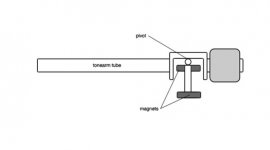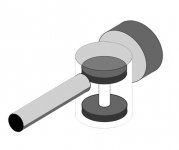Greetings,
For awhile now I've been planning out a DIY tonearm. So far, a unipivot has seemed the best choice given my limited access to machining tools. However, the instability of unipivots has always bothered me. The standard ways that most manufacturers get around this, throwing a really low counterweight on, and giving the arm a high center of gravity, feel like sloppy workarounds.
So I've been dreaming about building an arm with a relatively high center of gravity, which would pretty much be free to tilt in any direction, and using magnets in some way to stabilize its movement. Graham does this with his newest tonearm, and its supposed to work very well. I think Grahams approach is out of my league right now given the tools I have, and copying his idea isnt in the spirit of DIY.
Recently, I stumbled upon an old patent in which a tonearm uses 2 opposing magnets to float arong a central shaft. While I don't want to copy this idea exactly, it inspired me to see if I cold use part of the idea. I've done a few drawings to show you what I mean:
For awhile now I've been planning out a DIY tonearm. So far, a unipivot has seemed the best choice given my limited access to machining tools. However, the instability of unipivots has always bothered me. The standard ways that most manufacturers get around this, throwing a really low counterweight on, and giving the arm a high center of gravity, feel like sloppy workarounds.
So I've been dreaming about building an arm with a relatively high center of gravity, which would pretty much be free to tilt in any direction, and using magnets in some way to stabilize its movement. Graham does this with his newest tonearm, and its supposed to work very well. I think Grahams approach is out of my league right now given the tools I have, and copying his idea isnt in the spirit of DIY.
Recently, I stumbled upon an old patent in which a tonearm uses 2 opposing magnets to float arong a central shaft. While I don't want to copy this idea exactly, it inspired me to see if I cold use part of the idea. I've done a few drawings to show you what I mean:
Attachments
The idea is to use 2 opposing magnets, and a normal unipivot. These magnets will be too weak to float the tonearm, but will provide a bit of damping suspension, and make the tonearm want to stay perpendicular to the record. The unipivot will be a downward facing jewel ball and cup. This way, the tonearm is still "grounded" so that vibrations have a pathway out.
I can think of 1 arm that uses a similar concept already, the Decca International tonearm, but it floats/damps the whole bearing shaft, not the tonearm itself. So the real question is, does anyone think that this will not work? I'm concerned that the magnets will not provide the stable support that I'm looking for, that the tonearm may wobble/oscillate, or that I'll still have to use weights or something else to help stabilize it, what do others think? I'm assuming there's a reason that this hasnt been tried before. If noone has any objections, I'll try to build a prototype to test out the idea.
Thanks,
Zach
I can think of 1 arm that uses a similar concept already, the Decca International tonearm, but it floats/damps the whole bearing shaft, not the tonearm itself. So the real question is, does anyone think that this will not work? I'm concerned that the magnets will not provide the stable support that I'm looking for, that the tonearm may wobble/oscillate, or that I'll still have to use weights or something else to help stabilize it, what do others think? I'm assuming there's a reason that this hasnt been tried before. If noone has any objections, I'll try to build a prototype to test out the idea.
Thanks,
Zach
Attachments
Capt Zach said:The standard ways that most manufacturers get around this, throwing a really low counterweight on, and giving the arm a high center of gravity, feel like sloppy workarounds.
So I've been dreaming about building an arm with a relatively high center of gravity,
I absolutely agree with you. The pivot should be at record height and the COG a little lower so as to give a high resonant frequency that is easily damped. I've put my money where my mouth is and this was the result.
http://www.diyaudio.com/forums/showthread.php?s=&threadid=10171&highlight=
Nice Work.
I remember reading about your arm awhile back, and it was partly responsible for my deciding to go this route. I'm very attracted to the concept of the unipivot, just their wiggly nature makes me a bit uneasy. I'd like to avoid using too much damping if possible.
Zach
I remember reading about your arm awhile back, and it was partly responsible for my deciding to go this route. I'm very attracted to the concept of the unipivot, just their wiggly nature makes me a bit uneasy. I'd like to avoid using too much damping if possible.
Zach
Capt Zach said:I'd like to avoid using too much damping if possible.
Absolutely. Use the absolute minimum. That's why I applied my damping the way I did.
Here's the fly in your ointment:
If the magnet arrangement is symmetrical about the Z axis then restriction of rocking motion will equally restrict movement around the (required) horizontal axis.
In theory you could arrange the magnets so that they were not symmetrical about the Z axis but you would have to be very, very careful to ensure that this did not mean that the damping changed as the arm moved across the record.
Basically, all unipivots suck.
If the magnet arrangement is symmetrical about the Z axis then restriction of rocking motion will equally restrict movement around the (required) horizontal axis.
In theory you could arrange the magnets so that they were not symmetrical about the Z axis but you would have to be very, very careful to ensure that this did not mean that the damping changed as the arm moved across the record.
Basically, all unipivots suck.
Mark Kelly said:Basically, all unipivots suck.
That's a little harsh - a bit like saying, "All gimballed arms rattle."
Yep, a bit harsh!
FWIW, heres my 2c: Build a regular one first and just pick a route for damping, say use EC8010's one.
Make the arm, fit and get it running OK. When you have lived with it for a little while, go back and revisit the idea to make your "better" second one. There are so many little issues to resolve in the making of an arm, that you are nearly better off making a rough one first and then making another where you have gained a lot of experience from the first.
BTW I'm not implying that you don't have experience!!! just that to me, it would seem easier that way.....
Fran
FWIW, heres my 2c: Build a regular one first and just pick a route for damping, say use EC8010's one.
Make the arm, fit and get it running OK. When you have lived with it for a little while, go back and revisit the idea to make your "better" second one. There are so many little issues to resolve in the making of an arm, that you are nearly better off making a rough one first and then making another where you have gained a lot of experience from the first.
BTW I'm not implying that you don't have experience!!! just that to me, it would seem easier that way.....
Fran
EC8010 said:
That's a little harsh - a bit like saying, "All gimballed arms rattle."
I happen to agree with that, too.
I guess it would be safe to say, "all arms suck." I'm just trying to make one that sucks as little as possible...
Interesting comments Mark Kelly, let me see if I understand you correctly. You're suggesting that if I make the magnets symmetical that the arm will want to remain stationary. And if I were to make them non symmetrical, then damping might be irregular, would this be caused by subtle changes in azimuth across the length of the disc?
woodturner-fran, I suppose this is supposed to be my "better" tonearm, I've already built a few, all of them sounded good, but I found the unipivot "wobble" and some small issues with azimuth to really bother me. So this is the 1st time I'm considering adding some sort of damping to rein them in. And building a gimbal arm is more or less out of the question...
Thanks,
Zach
Interesting comments Mark Kelly, let me see if I understand you correctly. You're suggesting that if I make the magnets symmetical that the arm will want to remain stationary. And if I were to make them non symmetrical, then damping might be irregular, would this be caused by subtle changes in azimuth across the length of the disc?
woodturner-fran, I suppose this is supposed to be my "better" tonearm, I've already built a few, all of them sounded good, but I found the unipivot "wobble" and some small issues with azimuth to really bother me. So this is the 1st time I'm considering adding some sort of damping to rein them in. And building a gimbal arm is more or less out of the question...
Thanks,
Zach
I'm hearing ya...
good luck on the build. When I built mine - which owes a lot to EC8010's arm - I thought the wobbly nature would really bug me. But in practice it really doesn't bother me at all and in use, tracking warps etc it really excels. Didn't think it would perform so good. No wonder they are the darling of the DIYer.
Fran
good luck on the build. When I built mine - which owes a lot to EC8010's arm - I thought the wobbly nature would really bug me. But in practice it really doesn't bother me at all and in use, tracking warps etc it really excels. Didn't think it would perform so good. No wonder they are the darling of the DIYer.
Fran
With all due respect to Mr. Mark Kelly, if he could describe exactly what aspects of the various tonearm bearings "suck" and how he arrived at these conclusions, it will eventually help in the design of better tonearms. This post is not intended to be a flame nor an idle appeal but a serious attempt to unravel the secrets of the mysterious tonearm.
- Status
- This old topic is closed. If you want to reopen this topic, contact a moderator using the "Report Post" button.
- Home
- Source & Line
- Analogue Source
- Unipivot ideas

